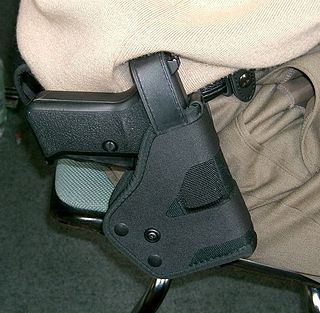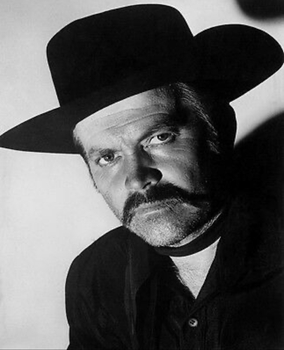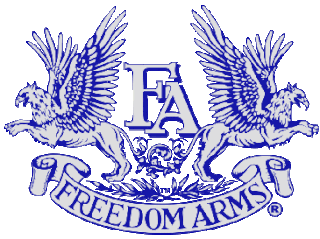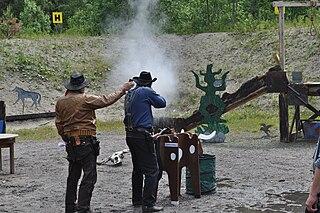
The Bridgeport rig is a quick draw or fast draw handgun holster that was developed in 1882. Today, the device enjoys cult status among cowboy action shooters and other antique gun enthusiasts.

The Bridgeport rig is a quick draw or fast draw handgun holster that was developed in 1882. Today, the device enjoys cult status among cowboy action shooters and other antique gun enthusiasts.
The Bridgeport rig was patented in 1882 by Louis S. Flatau, sheriff of Camp County, Texas. [1]
Flatau envisioned mounting the item on a belt or a saddle. A modified hammer screw with a large head that protruded 3/4" from the frame would be installed on the Colt. This screw head would be inserted into the rig and held in place via a strip of spring steel that was attached to the gun belt via rivets. The shooter could rotate the revolver upward to fire without removing it from his belt if needed. These were fabricated by the Bridgeport Gun Implement Company of Bridgeport, Connecticut. [2]
While the Flatau device was dismissed in military circles, it did enjoy limited acceptance among some frontier civilians, particularly peace officers and other professional gunmen who appreciated its speed of access. [2] A common complaint was that the screw was easily damaged and it failed to protect the revolver from the elements. [3]
Period photographs and scattered references indicate that the Bridgeport rig was used by some lawmen into the early 20th century. [2] Elmer Keith wore a Bridgeport rig as did James B. Gillett when he was Marshall of El Paso, Texas, in the 1880s; it is sometimes referred to as the "Gillett rig" for this reason. [2] [4]

I had always worn a pistol in a belt holster, and I was used to drawing fast from that position…A little later, I put on a belt which carried two Colts without a holster…I could swing the gun muzzles up or down, and they were out of the way and at the same time ready for instant use. I could shoot the pistols — though I never had to — without drawing them, just as one shoots out of an open-toed swivel holster.
— James B. Gillett, Marshall of El Paso in the 1880s

A revolver is a repeating handgun that has at least one barrel and uses a revolving cylinder containing multiple chambers for firing. Because most revolver models hold up to six cartridges, before needing to be reloaded, revolvers are commonly called six shooters or sixguns. Due to their rotating cylinder mechanism, they may also be called wheel guns.

The percussion cap, percussion primer, or caplock, introduced in the early 1820s, is a type of single-use percussion ignition device for muzzle loader firearm locks enabling them to fire reliably in any weather condition. Its invention gave rise to the caplock mechanism or percussion lock system which used percussion caps struck by the hammer to set off the gunpowder charge in rifles and cap and ball firearms. Any firearm using a caplock mechanism is a percussion gun. Any long gun with a cap-lock mechanism and rifled barrel is a percussion rifle. Cap and ball describes cap-lock firearms discharging a single bore-diameter spherical bullet with each shot.

Samuel Colt was an American inventor, industrialist, and businessman who established Colt's Patent Fire-Arms Manufacturing Company and made the mass production of revolvers commercially viable.

Gunfighters, also called gunslingers, or in the late 19th and early 20th century, gunmen were individuals in the American Old West who gained a reputation of being dangerous with a gun and participated in shootouts. Today, the term "gunslinger" is more or less used to denote someone who is quick on the draw with a handgun, but this can also refer to those armed with rifles and shotguns. The gunfighter is also one of the most popular characters in the Western genre and has appeared in associated films, television shows, video games, and literature.

The .45 Colt (11.43×33mmR), is a rimmed, straight-walled, handgun cartridge dating to 1872. It was originally a black-powder revolver round developed for the Colt Single Action Army revolver. This cartridge was adopted by the U.S. Army in 1873 and served as an official US military handgun cartridge for 19 years, before being replaced by the .38 Long Colt in 1892.

Ethan Allen was a major American arms maker from Massachusetts. He is unrelated to the revolutionary Ethan Allen. His first firearm, the "Pocket rifle" was developed in 1836, and his first patent was granted in 1837.

A handgun holster is a device used to hold or restrict the undesired movement of a handgun, most commonly in a location where it can be easily withdrawn for immediate use. Holsters are often attached to a belt or waistband, but they may be attached to other locations of the body. Holsters vary in the degree to which they secure or protect the firearm. Some holsters for law enforcement officers have a strap over the top of the holster to make the handgun less likely to fall out of the holster or harder for another person to grab the gun. Some holsters have a flap over the top to protect the gun from the elements.

Fast draw, also known as quick draw, is the ability to quickly draw a handgun and accurately fire it upon a target in the process. This skill was made popular by romanticized depictions of gunslingers in the Western genre, which in turn were inspired by famous historical gunfights in the American Old West.

Arvo Oswald Ojala was a Hollywood technical advisor on the subject of quick-draw with a revolver. He also worked as an actor; his most famous role was that of the unnamed man shot by Marshal Matt Dillon in the opening sequences of the long-running television series Gunsmoke. As a joke on the producers, James Arness and Arvo actually did the opener once with Dillon falling to the ground.

The M1917 Revolvers were six-shot, .45 ACP, large frame double action revolvers adopted by the United States Military in 1917, to supplement the standard M1911 pistol during World War I. There were two variations of the M1917, one made by Colt and the other by Smith & Wesson. They used moon-clips to hold the cartridges in position, facilitate reloading, and to aid in extraction since revolvers had been designed to eject rimmed cartridges and .45 ACP rounds were rimless for use with the magazine-fed M1911. After World War I, they gained a strong following among civilian shooters. A commercial rimmed cartridge, the .45 Auto Rim, was also developed, so M1917 revolvers could eject cartridge cases without using moon-clips.

In American English, a pocket pistol is any small, pocket-sized semi-automatic pistol, and is suitable for concealed carry in a pocket or a similar small space.

The Remington-Beals Model Revolvers along with subsequent models and variations were percussion revolvers manufactured by Eliphalet Remington & Sons in .31 (Pocket) .36 (Navy) or .44 (Army) caliber, used during the American Civil War, and was the beginning of a successful line of medium and large frame pistols. They are commonly, though inaccurately, referred to as the Model 1858 due to the patent markings on its New Model barrels, "PATENTED SEPT. 14, 1858/E. REMINGTON & SONS, ILION, NEW YORK, U.S.A./NEW MODEL."; although wide scale production did not start until 1861.

A handgun is a firearm designed to be usable with only one hand. It is distinguished from a long gun which needs to be held by both hands and braced against the shoulder. Handguns have shorter effective ranges compared to long guns, and are much harder to shoot accurately. While most early handguns are single-shot pistols, the two most common types of handguns used in modern times are revolvers and semi-automatic pistols, although other handguns such as derringers and machine pistols also see infrequent usage.

The Colt Paterson revolver was the first commercial repeating firearm employing a revolving cylinder with multiple chambers aligned with a single, stationary barrel. Its design was patented by Samuel Colt on February 25, 1836, in the United States, England and France, and it derived its name from being produced in Paterson, New Jersey. Initially this 5 shot revolver was produced in .28 caliber, with a .36 caliber model following a year later. As originally designed and produced, no loading lever was included with the revolver; a user had to partially disassemble the revolver to re-load it. Starting in 1839, however, a reloading lever and a capping window were incorporated into the design, allowing reloading without disassembly. This loading lever and capping window design change was also incorporated after the fact into most Colt Paterson revolvers that had been produced from 1836 until 1839. Unlike later revolvers, a folding trigger was incorporated into the Colt Paterson. The trigger became visible only upon cocking the hammer.

The Colt Revolving Belt Pistol or Navy Pistol, sometimes erroneously referred to as "Colt Revolving Belt Pistol of Naval Caliber" or "of Navy Caliber", is a .36 caliber, six-round cap and ball revolver that was designed by Samuel Colt between 1847 and 1850. Colt first referred to this Revolver as the Ranger Size model, and then Revolving Belt, but the designation "Navy" quickly took over.

The family of Colt Pocket Percussion Revolvers evolved from the earlier commercial revolvers marketed by the Patent Arms Manufacturing Company of Paterson, N.J. The smaller versions of Colt's first revolvers are also called "Baby Patersons" by collectors and were produced first in .28 to .31 caliber, and later in .36 caliber, by means of rebating the frame and adding a "step" to the cylinder to increase diameter. The .31 caliber carried over into Samuel Colt's second venture in the arms trade in the form of the "Baby Dragoon"-a small revolver developed in 1847–48. The "Baby Dragoon" was in parallel development with Colt's other revolvers and, by 1850, it had evolved into the "Colt's Revolving Pocket Pistol" that collectors now name "The Pocket Model of 1849". It is a smaller brother of the more famous "Colt's Revolving Belt Pistol of Naval Caliber" introduced the same year and commonly designated by collectors as the "1851 Navy Model". In 1855 Colt introduced another pocket percussion revolver, the Colt 1855 "Sidehammer", designed alongside engineer Elisha K. Root.

The Colt New Service is a large frame, large caliber, double-action revolver made by Colt from 1898 until 1941. Made in various calibers, the .45 Colt version with a 5½" barrel, was adopted by the U.S. Armed Forces as the Model 1909.

Freedom Arms is a Freedom, Wyoming based firearm manufacturing company, known for producing powerful single-action revolvers. The company was founded in 1978 by Wayne Baker and Dick Casull to produce the Mini-Revolver, then later a revolver chambered in Casull's powerful .454 Casull revolver cartridge. This 5-shot revolver was the Model 83. Freedom Arms currently makes a single-shot pistol in addition to their revolvers.

Merwin, Hulbert, and Co. or Merwin Hulbert was an American firearms designer and marketer based in New York City which produced revolvers and rifles from 1874 to 1896. The firearms were manufactured by a subsidiary company, Hopkins & Allen of Norwich, Connecticut. Merwin Hulbert's designs had influenced other gunmakers of the time, such as Meriden Firearms Co., Harrington & Richardson, Forehand & Wadsworth, and Iver Johnson.

Cowboy action shooting is a competitive shooting sport that originated in the early 1980s, at the Coto de Caza Shooting Range in Orange County, California. Cowboy action shooting is now practiced in many places with several sanctioning organizations including the Single Action Shooting Society (SASS), Western Action Shootists Association (WASA), and National Congress of Old West Shooters (NCOWS), and Single Action Shooting Australia (SASA).